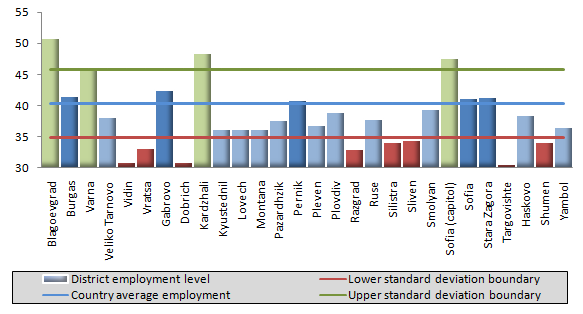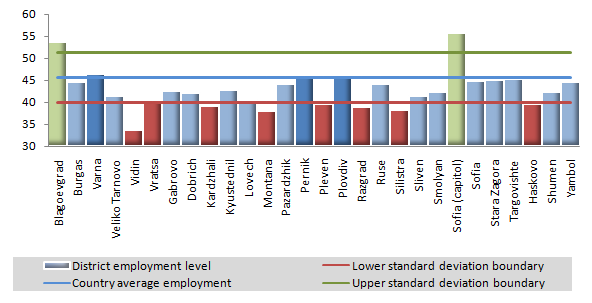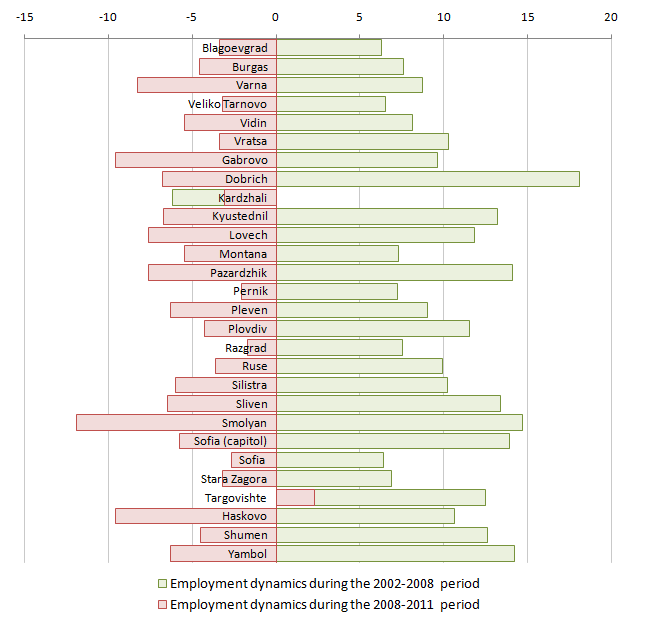Where Did People Manage to Keep Their Jobs in the Last Ten Years?
Yavor Alexiev
In the past few years, the state of the labor market in Bulgaria is mostly defined by:
- the huge number of jobs lost
- dropping employment rates and growing unemployment
- frequent increases in social security burden
A more comprehensive review of the state of the labor market on a regional level reveals troubling trends in certain regions.
To demonstrate these trends, we will divide the last ten years, of available regional labor market data in two periods. The first period is the pre-crisis years between 2002 and 2008, and the second one – the crisis years between 2008 and 2011.
The acceleration of economic activity in Bulgaria during the pre-crisis years is not an even process – the rise in overall employment leads to a widening �of the gap between Bulgaria’s regions.
The main factor for this process is the economic and demographic development of Sofia (capital). In the pre-crisis period the average employment in the country was rising because of the new jobs created in the capital. Employment in certain smaller districts such as Dobritch, Pazardzik, Smolyan and Yambol also rose rapidly before 2008, but a main reason for the latter is the drop in overall population in these regions as well as the small employment base in the beginning of the period. The effect of the increase of employment in these districts on the country average is quite negligible.
Regional employment in 2002 and 2011
In 2002. there are nine regions where the annual average employment is higher than the country average. In four of them – Blagoevgrad, Varna, Kardzhali and Sofia (capital) annual employment exceeds the standard deviation for the country.
Graph 1: Employment rates in the population above 15 years of age (2002), %
 �
�
Source: IME calculations based on NSI data
By the end of 2011 the regions where employment rate is higher than the country average are only five, while in two of them – Blagoevgrad and Sofia (capital) – employment is higher than the upper boundary of the standard deviation (Graph 3). This occurs against the background of an increasing annual average employment in the economy – from 40.3% in 2002 up to 45.6% in 2011.
Graph 2: Employment rates for the population aged 15 years and above (2011), %

Source: IME calculations based on NSI data
Sofia (capital) and Blagoevgrad have managed to keep their leading positions in employment levels. Employment in Blagoevgrad and in the capital is the highest in 2002 as well as in 2011. Sofia (capital) has kept its leading position due to its high economic activity, Blagoevgrad – due to its good business environment and partially due to its proximity to the capital. Pernik, Plovdiv, Sofia and Stara Zagora also perform well. In the same time, employment in the bigger regions like Burgas, Stara Zagora, Gabrovo and Sofia increases at slower rates than the country average and has fallen below the country average in 2011.
Graph 3: Dynamics of employment in the pre-crisis and crisis periods, p.p.

Source: IME calculations based on NSI data
As it can be seen on Graph 3, Targovishte is the only region in the country where employment rises in the end of both periods, respectively from 30.6% in 2002 to 43.1% in 2008, an later on up to 45.40% for 2011. Even though the highest employment rates are recorded in 2009 (45.6%), the crisis has a negligible effect on employment in the district compared to the other regions of the country. In the past 10 years Targovishte has turned from the district with the lowest employment rate in the country into the one with the sixth highest employment, reaching levels close to the country average. Among the main reasons for the region’s good performance are the low base at the beginning of the period, as well as the improving business environment, which has helped attract investment.
Kardzhali features as exactly the opposite case. The district is the only one which shows a drop in the employed population both during the crisis and in the previous period. An interesting fact is that in 2002 employment in Kardzhali is higher than that in the capital, with only employment in Blagoevgrad reaching higher levels. Despite that, in the past 10 years it has dropped by almost 10 percentage points, which leaves it well under the country average in 2011.
When it comes to employment, the crisis has destroyed all positive employment developments in Haskovo, Smolyan, Gabrovo and Varna.
What can happen in 2013?
The gap in economic activity between the regions is likely to grow bigger in the upcoming period. This is based on the negative demographic trends, relatively low foreign investment and increasing social security burden. The latter in particular has a negative effect on smaller districts, where due to lower economic activity and the limited local markets, wages in many spheres of the economy are close to the minimum �social security thresholds.
In the same time, the dynamics of the labor market in Kardzhali and Targovishte shows how important the efforts of the local administration are for the development of a better business environment. It is exactly the favourable business environment that increases the investment attractiveness of a district, which leads to an increase in economic activity and new jobs.
The project “Regional Profiles: Indicators of Development” is carried out with the financial support of the America for Bulgaria Foundation.

